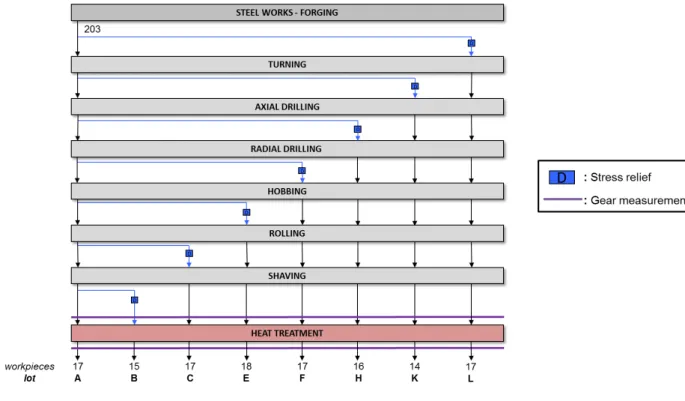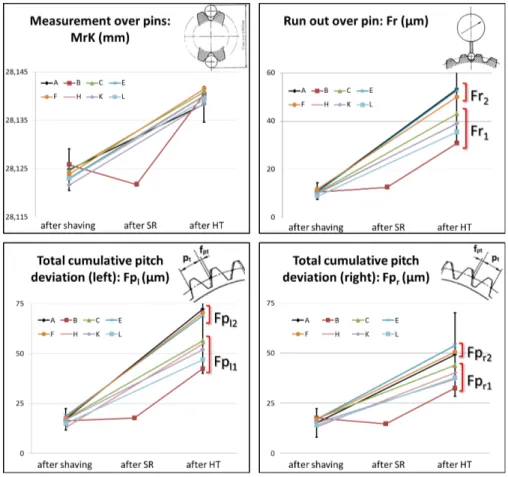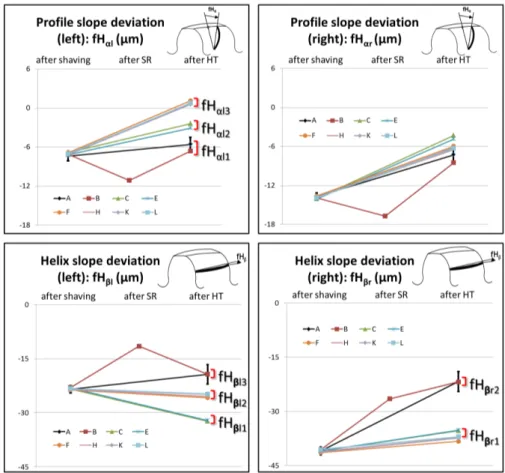is an open access repository that collects the work of Arts et Métiers Institute of Technology researchers and makes it freely available over the web where possible.
This is an author-deposited version published in: https://sam.ensam.eu
Handle ID: .http://hdl.handle.net/10985/7657
To cite this version :
Rémi HUSSON, Cyrille BAUDOUIN, Régis BIGOT, Eduardo SURA - Experimental identification of the process inffluences on gear distortion during heat treatment - In: Congrès français de
mécanique (21 ; 2013 ; Bordeaux (Gironde))., France, 2013-08-26 - Congrès français de mécanique (21 ; 2013 ; Bordeaux (Gironde)). - 2013
Experimental identification of the process influences on
gear distortion during heat treatment
R. Husson a,b, C. Baudouin a, R. Bigota, E. Surab
a. Arts et M´etiers ParisTech Metz, Laboratoire de Conception Fabrication Commande (EA 4495) b. Renault, Powertrain Process Engineering Division
R´
esum´
e :
Le traitement thermique est utilis´e dans l’industrie automobile afin d’am´eliorer les propri´et´es m´ecaniques des pi`eces fabriqu´ees. Il a ´egalement pour effet secondaire de conduire `a des d´eformations g´eom´etriques. La litt´erature scientifique et les retours d’exp´erience industriels montrent que l’ensemble de la gamme de fabrication en amont du traitement thermique joue un rˆole dans l’apparition des d´efauts. L’ob-jectif des travaux vise `a d´eterminer exp´erimentalement l’influence de chaque ´etape de fabrication en amont du traitement thermique sur les d´eformations des dentures, par neutralisation des contraintes r´esiduelles. Les r´esultats permettent de relier chaque type de d´eformation sur les param`etres g´eom´etriques de la denture `a une ou plusieurs ´etapes de fabrication en particulier. Lorsqu’une d´erive sur le proc´ed´e est d´etect´ee sur un crit`ere g´eom´etrique, la m´ethode ainsi d´evelopp´ee permet de diagnostiquer l’origine du d´efaut au sein de la gamme de fabrication amont.
Abstract :
Heat treatment is widely used in automotive industry to improve mechanical properties of workpieces. It also generates side effects such as geometrical distortions. Scientific literature and experience show that the manufacturing process chain has an influence on heat treatment distortion. The purpose of the presented work is to experimentally determine the influence of each pre-heat treatment step on gear distortion. Residual stress is being neutralized and by comparison, connections between gear teeth geometry and manufacturing step are obtained. As a consequence, non-conformities roots can be determined more easily thanks to this diagnosis tool.
Keywords :
Heat-treatment ; Gear ; Manufacturing1
Introduction
1.1
Context
Geometrical variations during heat treatment are on global and local scales [1]. Distortion is related to several causes. This study focuses on residual stress, which is one of these factors. Its influences on distortion after heat treatment is evaluated through experiments. In our case, majors distortions during heat treatment occur on gear teeth at two geometrical scales. The global aim of this project is to support both the design and the development of the manufacturing process chain. Thus, it will improve the control of gear quality.
1.2
State of the art
First of all, distortion during heat treatment is a consequence of these major phenomena :
– spatial and temporal heterogeneity of temperature during heating and quenching which leads to heterogeneous expansion [2] ;
Figure 1 – Process chain and carriers of distortion potential of a typical component for the trans-mission industry before operational behaviour [4].
– decrease of yield strength when temperature increases which causes stress relief by plastic deforma-tion [2].
One idea is to consider distortion after heat treatment as the result of a distortion potential gradually stored into the material all through the process [3]. Each manufacturing step contributes to the distortion potential which is physically related to physical carriers. Carriers present dependencies on each other, as shown in Figure 1 [4].
1.3
Objective
In this study, the manufacturing process includes cold forging, machining and heat treatment. First, the relief of residual stress induced by forging affects distortion [5]. Then, during machining steps, gear hobbing modifies residual stress distribution and distortion [6]. Consequently, among all carriers of distortion potential described in Figure 1, this study first focuses on residual stress. The global aim of this project is to improve the understanding of gearbox shafts distortion during heat treatment. Experiments are carried out with a gearbox shaft of automotive industry. During our experiments, the manufacturing process presented in Figure 3 is not necessarily the same as industrial one in terms of technology and chronology. Nevertheless, the manufacturing process has been chosen to emphasise influences of residual stress on heat treatment distortion.
2
Experiments
2.1
Experimental Procedure
By considering two manufacturing step k and k − 1 as represented in Figure 2, two lots are compared. In order to observe the influence of a carrier of potential distortion, this carrier is neutralized between these two steps. After manufacturing step k − 1, both lots A and B have the same geometry GA(k−1)
and GB(k−1). Then, lot A goes directly to next manufacturing step k to obtain geometry GA(k) while
lot B is being ”neutralized”. At last, lot B will pass through manufacturing step k leading to geome-try GB(k). In the case of a geometrical deformation due to the neutralization, this variation can be checked thanks to a comparison between GB(k−1)N and GB(k−1). Finally, by comparing geometry of lot A (GA(k)) and lot B (GB(k)) after manufacturing step k, the influence of the carrier of distortion potential is revealed.
This approach has been applied to an experimental manufacturing process, as presented in Figure 3. The neutralization that has been chosen is a 4-hour 600˚C stress relief (designated by ”SR”). Its
effi-ciency to decrease significantly residual stress has been checked [7]. 8 lots are considered : 1 lot without any stress relief and 7 lots that are stress relieved once during their manufacturing history. Thus, 131 workpieces are manufactured under similar conditions in terms of time, tools and machines. Some parts have been removed, which explains non homogeneous lots. At last, each workpiece is identified with a letter from its lot name. Gears are measured by a coordinate-measuring machine whose uncertain-ties are evaluated to 5 µm for first scale of gears (cf. Figure 4) and 3 µm for second scale (cf. Figure 5).
Figure 2 – Experimental Principle, 2 different lots (A, B) are set up after manufacturing step k − 1. Contrary to lot B, lot A is not neutralized. By comparing geometry of lot A and lot B after manufacturing step k, the influence of the carrier of distortion potential is revealed.
Figure3 – Experimental manufacturing process and procedure. Each one of 7 lots B, C, E, F, H, K, L is stress relieved once during its history. By comparing geometry of two lots, the influence of the carrier of distortion potential is revealed.
2.2
Results
Hobbing process is not capable to deliver gear geometry that is exploitable at a small geometrical scale. For this reason, the evolution of geometry during stress relief for all lots except B is not presented here. First level of gear parameters results as defined in [8] is presented in Figure 4. The four levels increase during heat treatment. For instance measurement over pins M rK rises to about 0.15 mm. Dispersion
is high for the other parameters. Nevertheless, it is possible to identify qualitative tendencies and to rank all the lots in two categories for run out over pin F r and total cumulative pitch deviation F p : – lots B, C, H, K, L are stress relieved respectively after shaving, rolling, axial drilling, turning and
forging. Values of F r1, F pl1 and F pr1 are attributed.
– lots E and F are stress relieved after hobbing and radial drilling. Values of F r2, F pl2 and F pr2 are
attributed.
Lot B has small geometrical variations during stress relief for the four considered parameters. Ho-wever, a small decrease is visible for measurement over pins. In other words, stress relief leads to a slight contraction of the gear. Other first level parameters are not sensible to variations. During heat treatment, lot B has the lowest run out over pin F r and total cumulative pitch deviation F p.
Figure 4 – Evolution of measurement over pins M rK, run out over pin F r and total cumulative pitch deviation for left (F pl) and right flanks (F pr) of 8 lots during heat treatment (HT). Lot B is
the only one to be stress relieved (SR) after shaving. Lot A is represented with its uncertainty. At a second level of analysis, profile and helix slope deviations results are presented in Figure 5. Dis-persion is lower than previously and it is easier to distinguish various behaviours. The mean value is calculated on three teeth for lot A (standard workpieces) and is worth less than 1 µm after shaving and less than 2 µm after heat treatment, which is below measurement uncertainty. Here, comparison between lots is quantitatively exploitable. Proximity between values regarding the profile slope devia-tion f Hαris too small and does not allow a valid classification for this parameter. The right helix can
be separated in two groups : lot B with the value f Hβr2 and the other lots with the value f Hβr1.
Profile and helix on the left flank enable a classification visible in Figure 5 : – lot B is stress relieved after shaving. Values of f Hαl1 and f Hβl3 are attributed.
– lots C and E are stress relieved respectively after rolling and after hobbing. Values of f Hαl2 and
– lots F , H, K, and L are stress relieved respectively after radial drilling, after axial drilling, after turning and after forging. Values of f Hαl3 and f Hβl2 are attributed.
Lot B workpieces have almost similar values for second level parameters after heat treatment than lot A ones. This means that, stress relief after shaving does not influence the final gear geometry of second level teeth geometry.
Figure 5 – Evolution of profile slope deviation (f Hα) and helix slope deviation (f Hβ) for left and right flanks of 8 lots during heat treatment (HT). Lot B is the only one to be stress relieved (SR) after shaving. Lot A is represented with its uncertainty.
2.3
Discussion
First, both gear levels showed different classifications. Consequently, gear distortion during heat treat-ment depends on the geometrical scale. Then, the approach by neutralization and comparison can be applied thanks to previous results. The purpose is to determine the influence of the carrier of distortion potential on the gear distortion. In our case, this carrier is ”residual stress” and it is correlated to each manufacturing step. To obtain its influence, differences between previously obtained values are calculated and presented in Table 1.
At first geometrical level, only two manufacturing steps modifies significantly the ”residual stress” car-rier of distortion : radial drilling and rolling. Radial drilling appears as favourable for first level gear geometry. On the contrary, rolling modifies the residual stress distribution in such a way that it leads to an unfavourable impact on the shaft after heat treatment. Rolling is a cold-press forming process. If the geometrical and stress balance between the two rolling racks and both tips is not respected, then residual stress can be heterogeneous. It may cause deformation during heat treatment.
Step Difference First level Second Level between lots Gear Teeth Gear Teeth
Fr, Fpl, Fpr f Hαl f Hαr f Hβl f Hβr Turning L - K NS NS NA NS NS Axial Drilling K - H NS NS NA NS NS Radial Drilling H - F <0 NS NA NS NS Hobbing F - E NS >0 NA >0 NS Rolling E - C >0 NS NA NS NS Shaving C - B NS >0 NA <0 <0
Table1 – Influence of each manufacturing step on the teeth distortion potential through the carrier ”residual stress”. The indicated value takes into account the norm but not its sign. ”NS” refers to non-significant and ”NA” to not applicable.
In the case of the second geometrical level, only hobbing and shaving have an influence on profile and helix slope deviations. Hobbing and shaving are respectively rough machining and finish machining of the gear. Consequently, they are implicitly linked to the gear geometry. But their influences depend on gear parameter according to Table 1. For example in the case of profile slope deviation of the left flank f Hαl, hobbing and shaving tend to increase the distortion potential because of the ”residual
stress” carrier. Results also show possible correlations between profile slope deviation of the left flank f Hαl and helix slope deviation of the left flank f Hβl because classification between lots is similar.
3
Conclusions and Perspectives
Thanks to the presented study, each gear geometrical parameter can be related to manufacturing steps. By neutralization and comparison, the ”residual stress” carrier of distortion potential has been revea-led. As a consequence, when a non-conformity is detected after heat treatment for this experimental process, the synthesis table can be used as a diagnosis tool to correct machining parameters. Thanks to these results, time and cost savings will be earned during production. New production lines will be designed taking into account this feedback. Another further study on the shaft bending and correlation between various geometrical scales would provide more data about the complex phenomenon of heat treatment distortion.
R´
ef´
erences
[5] Cho, J. R., Kang, W.J., Kim, M.G., Lee, J.H., Lee, Y.S., Bae, W.B. 2004 Distortions induced by heat treatment of automotive bevel gears Journal of Materials Processing Technology 153 476-481 [2] Cook, W.T. 1999 A review of selected steel-related factors controlling distortion in heat-treatable
steels Heat treatment of metals 26 27-36
[8] Goch, G. 2003 Gear Metrology Annals of the CIRP 52(2) 659-695
[3] Hoffmann, F., Keßler, O., L¨ubben, T., Mayr, P. 2002 ”Distortion Engineering” Verzugsbeherr-schung in der Fertigung HTM 57/3 213-217
[7] Husson, R., Dantan, J.-Y., Baudouin, C., Silvani, S., Scheer, T. and Bigot,R. 2012 Evaluation of process causes and influences of residual stress on gear distortion Annals of the CIRP 61(1) 551-554 [6] Kohlhoff, T. 2009 Analysis of the forces in different regions during hobbing and their effect on
distortion Materialwissenschaft und werkstofftechnik 40 390-395
[1] Kohlhoff, T., Prinz, C., Rentsch, R., Surm, H. 2011 Influence of manufacturing parameters on gear distortion Proceedings of the 3rd International Conference on Distortion Engineering 2011, Bremen, September 14th to 16th pp. 155-165
[4] Zoch, H.-W 2009 Distortion Engineering : vision or ready to application Materialwissenschaft und Werkstofftechnik 40/5,6 342-348
![Figure 1 – Process chain and carriers of distortion potential of a typical component for the trans- trans-mission industry before operational behaviour [4].](https://thumb-eu.123doks.com/thumbv2/123doknet/7392812.216604/3.892.173.729.83.361/process-carriers-distortion-potential-component-industry-operational-behaviour.webp)



